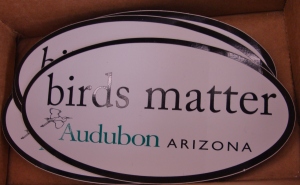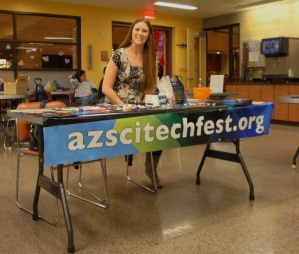Mark your calendar – dates are still being added, with back-up guides, too, as more avian experts sign up to assist with guided bird walks at Boyce Thompson Arboretum. This spring BTA has a new guide joining the team, Carlos Oldham March 9 & 15, who encourages “beginner birders and novices” who’d be more comfortable with their own guide and beginners’ walk – and not feel out of place o a walk with experienced birders. The Winter-Spring schedule begins Feb. 1 with two leaders: Arizona Game & Fish Department avian expert Troy Corman (co-author of the state Breeding Bird Atlas, and a founder of the AZ Field Ornithologists association) along with Scottsdale educator Kathe Anderson. Feb. 9 the guide is photographer Richard Ditch [http://www.richditch.com/]** click this link to see his breathtaking photography; or browse a gallery of birder vanity plates [http://www.richditch.com/page88/page88.html]
then on Feb. 15 Anne Leight leads the walk (she also volunteers as a bird-banding researcher at TNC’s Hassayampa River preserve); Feb. 23 brings the choice of three leaders with Cindy West, Cathy Wise & Justin Jones. Troy & Kathe return as guides March 1; Anne Leight returns March 9, and Justin Jones March 15. This next one’s still ‘a little iffy,’ so check BTA’s website events page in March to verify this, but Sunday March 16 may bring a special ‘meet the AZFO;’ birdwalk guided by board members of the Arizona Field Ornithologists association from 8:30-10:30am, prior to their meeting in the lecture room (again, revisit BTA’s website in March to verify that). On March 23 guides are Marceline Vandewater & Anne Leight. There’s a special ‘back-to-back weekend’ of bird walks March 29-30 each day guided by Craig Anderson; then April 5 our guide is Richard Ditch; April 13 is Anne Leight (with ASU’s Nathan Williams as backup); April 19 is Kathe Anderson and April 27 is Anne Leight &
Nathan.
Verify tour dates on the BTA event page
[http://arboretum.ag.arizona.edu/events.html]
Read birder checklist reports:
[http://arboretum.ag.arizona.edu/events/birdwalks.html]
OK the doors are open and the men have f
OK the doors are open and the men have found the refreshments – still time to come and make claim to your cupcake or brownie before the meeting begins.
Getting ready for the meeting tonight –
Getting ready for the meeting tonight – all about landscaping for wildlife. Russ Haughey is presenting the program in readiness for our Tour de Bird next month.
http://ow.ly/d/1viM
Getting ready to start our first meeting
Getting ready to start our first meeting of the season at South Eastern Regional Library.
Ribbons of Green
It was a hot day at the Rio Salado Nature Center in Phoenix but the center was full of people; people who had given up a precious Saturday, people who had driven from as far away as Prescott and Yuma, people ready to listen and learn. Outside, despite the heat,a few birds flew over the almost dry River Salt and dragonflies zipped by over the small pond where the young Cottonwoods were trembling in the heat. Yet the audience inside resolutely turned their backs on the scene to concentrate on what was being said inside, and they did that because they fully appreciate the importance of water in our desert lands.
It was the second workshop meeting of the Western Rivers Action Network (WRAN), held so that interested societies and individuals could come together to address the issues that threaten all of the rivers in the Western United States. Up until now it has been up to separate and often isolated groups to fight for specific rivers but, as the climate gets dryer and the pressure on our waterways increases with population growth, we need a less fragmented approach.
Hence the formation of WRAN and this meeting was held to start the ball rolling on formulating policies for the new group. We had lots of wonderful people come to talk to us, we shared ideas and information. For me though there was one powerful phrase that Tice Supplee used when she was talking about Important Bird Areas. She showed an aerial photograph of one of Arizona’s rivers. It was mostly the dusty brown color we know so well but, along the length of the river the trees grew in what she described as “a ribbon of green.”
An that, in essence, is what WRAN is all about. Preserving those “ribbons of green” for the animals and plants that depend on them now, for the people who have made Arizona their home, for the future generations who should enjoy the same beauty of such a unique ecosystem.
So what can you do? Maybe a little, maybe a lot, but first and foremost you can try this website – http://az.audubon.org/rivers-and-water-0
You can sign up here to become part of the network and you’ll be kept informed of what WRAN is doing and how you can help.
Then you can sign the petition at http://www.audubonaction.org/ProtectAZrivers
and finally – because this is not just about Arizona’s rivers but a wider issue you can read the multi-state newsletter at
http://www.audubonaction.org/site/MessageViewer?em_id=28561.0&pgwrap=n
Water affects us all – every drop is precious and to protect that water every person is precious. Please join with us.
Zanjero Park Burrowing Owl spring update
OwlWatch Coordinator
stacymb@cox.net

Greg Clark, Burrowing Owl Project Coordinator for Wild at Heart, introduces the ten burrowing owls to be released into Zanjero Park, Gilbert, Fall 2011.
I apologize for being way overdue in giving you an update on the owls at Zanjero. With that said, I can’t go into too much detail right now but in short we have two pairs in full courtship mode, each madly prepping one or more burrows as a nest burrow. The males are also getting very protective starting to dive bomb dogs being walked along the sidewalk.
Tech Night, April 9, 2013, Smartphones and Other Technology Helping Hikers and Wildlife in AZ
Join us Tuesday, April 9, 2013, 7:00 pm, Gilbert Community Center, 130 North Oak Street, Gilbert for Tech Night-Smartphones & Other Technology Helping Hikers & Wildlife in AZ.

Jamie Bradford (far right), Desert Rivers Audubon’s Education Director, works with developers from Spark Design, Tempe.
Come early to browse our mobile book shop, visit, and discover volunteer opportunities with Desert Rivers Audubon.
FREE. Light refreshments served.
Audubon launches multistate Rivers Advocacy Network
In the arid West we are all connected by rivers; they are the lifeblood of our land, our economy, our way of life. Western rivers—including the Colorado, the Verde, the Gila and the San Pedro, provide water for tens of millions of people, including twenty-two Native American tribes and the cities of Denver, Phoenix, Albuquerque and Tucson.
We aren’t alone in our reliance on western rivers. Ninety percent of Central Flyway birds depend on these waterways for their survival.
Unfortunately our rivers are in jeopardy. Drought, invasive species, over-allocation and unsustainable management are running our rivers dry. Many of the birds that depend on them, like the Western Yellow-billed Cuckoo and Bell’s Vireo, are in decline, and the future of the communities and economies surrounding our rivers is uncertain.
Audubon is taking a major step to address the threats to our western rivers. This spring we’re launching the Western Rivers Action Network, a multistate grassroots coalition to advocate for our rivers and the bird species that depend on them.
To lead the development of the Arizona network, we’ve engaged Sarah Luna, a seasoned conservation professional who brings a  wealth of skills to Audubon. Sarah will be reaching out to Audubon members across the state to get your input on how to make the Western Rivers Action Network a success and to find out how the network can support your chapter’s riparian conservation work.
wealth of skills to Audubon. Sarah will be reaching out to Audubon members across the state to get your input on how to make the Western Rivers Action Network a success and to find out how the network can support your chapter’s riparian conservation work.
Interested in being a part of the Western Rivers Action Network? There are many opportunities for volunteer advocates! Contact us to find out more. Email riosalado@audubon.org or Sarah Porter at sporter@audubon.org.
‘Second Chance for Wild Wings’ with Liberty Wildlife, part of the Arizona SciTech Festival, March 12
Join us Tuesday, March 12, 7:00 pm, Gilbert Community Center, 130 North Oak Street, Gilbert for Second Chance for Wild Wings as volunteers with Liberty Wildlife demonstrate the resilience and care required of injured Arizona wildlife.
Bring kids & cameras as we visit with some of Arizona’s most charismatic birds (which may include eagles, owls or hawks).
Come early to browse our mobile book shop, visit, and discover volunteer opportunities with Desert Rivers Audubon.
FREE. Light refreshments served.
 Part of the Arizona Scitech Festival.
Part of the Arizona Scitech Festival.
Spearheaded by Arizona Science Center, the Arizona Technology Council Foundation, Arizona Commerce Authority, Arizona State University, and the University of Arizona and over 350 organizations statewide, the Arizona SciTech Festival, held annually in February and March celebrates the scientific wonders, resources, and opportunities in our state and their potential global impact.


